Business
Peru’s mining sector: It’s complicated
Lima’s future with a dwindling water supply
Peru has the fifth biggest supply of fresh water in the Americas. The trouble is it’s on the eastern side of the Andes mountains in the Amazon. Two thirds of population, most of the economic activity and the capital city are the other side which gets just 2% of the nation’s water supply.
Corruption and Peru’s dismal electoral options
Two former presidents investigated for corruption, another serving time convicted for graft and human rights crimes. Roll on 2016.
The nature business
Finding a marketplace for the Amazon rainforest. Eco-tourism as a conservation tool.
Peru’s broadening middle class
“Because we don’t have anything we’ll do everything.” was the motto in Villa El Salvador, the burgeoning suburb in Lima’s south. These hard working values are instilled in the new generations who are Peru’s new middle class.
Haute cuisine in – wait for it – Bolivia!
Dan Collyns takes us to the trendiest new restaurant in La Paz, Bolivia, the brainchild of top Danish chef and Noma founder, Claus Meyer. Could it be the vanguard of a gastronomic revolution in the land-locked country.
Cocaine: History between the Lines
Dan Collyns worked as the Peru producer on this feature-length History Channel documentary about the cocaine trade. Toby Barraud of NFGTV hired Dan to get the inside track on the drugs war at source.
A sweet alternative

From cocaine to chocolate. Can cocoa really be a substitute for the leaf that makes cocaine?
How a Peruvian island is making money from bird poo

Guanape Sur island off northern Peru makes money from selling bird droppings – also known as guano. Commonly used in the 19th Century as a fertiliser, this organic product is making a comeback.
Two types of sea bird whose droppings produce guano – the Peruvian Booby and Guanay Cormorant – are protected. About 300 men live and work on the island for eight months of the year.
The guano is shipped off to organic farmers in Peru’s mountains and jungle. Peru is the world’s number one guano producer, with 30,000 tonnes a year.